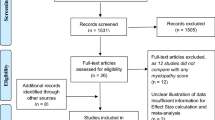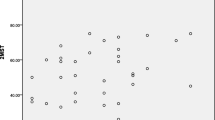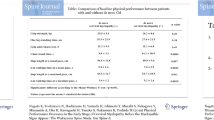Abstract
Cervical compressive myelopathy (CCM) is one of the common neurological disorders seen in the geriatric population. The 10-s Grip and Release (“G and R”) Test and the 30-m Walking (“Walking”) Test are widely known as quantifiable physical assessments for the severity of cervical myelopathy. We developed the 10-s Step (“Step”) Test as another easily performable quantifiable measure for this. However, it is not clear if the Step test can adequately reveal the severity of myelopathy like the other established tests, given its simple method. The purpose of this study was to verify the practical effectiveness of this Step Test as a quantifiable parameter of CCM in comparison with the other two established tests. 168 consecutive patients with CCM were selected. Only 101 patients having >12-month postoperative follow-up were included. All were treated with cervical expansive laminoplasty. The three above mentioned quantitative tests and two assessment questionnaires (Japanese Orthopedic Association [JOA] Score, and lower-limb-function section of the Japanese Orthopedic Association cervical myelopathy evaluation questionnaire [JOACMEQ-L]) for CCM were prospectively administered, and the results of the three tests were evaluated using linear regression models to determine which quantitative test best reflected the results of the JOA score and JOACMEQ-L. Each quantitative test was carried out twice, just before and 1 year after surgery. The intraobserver reproducibility of the 10-s Step Test was found to be as high as that of the other tests both before and after surgery. Linear regression analyses showed that the results of the Step Test correlated with JOA scores to the same degree as the Walking Test results did, and to a greater degree than the G and R Test results did. Moreover, the results of the Step Test showed a significant degree of correlation with JOACMEQ-L. In view of these findings, our conclusion was that the easily performed Step Test is an useful test for assessing the severity of cervical myelopathy, especially for the lower limb dysfunction secondary to CCM.
Similar content being viewed by others
References
Bertalanffy H, Eggert HR (1989) Complications of anterior cervical discectomy without fusion in 450 consecutive patients. Acta Neurochir (Wien) 99:41–50
Clark CR (1988) Cervical spondylotic myelopathy: history, physical findings. Spine 13:847–849
Fukui M, Chiba K, Kawakami M et al (2007) An outcome measure for patients with cervical myelopathy: Japanese Orthopaedic Association Cervical Myelopathy Evaluation Questionnaire (JOACMEQ): part 1. J Orthop Sci 12:227–240
Fukui M, Chiba K, Kawakami M et al (2007) Japanese Orthopaedic Association Cervical Myelopathy Evaluation Questionnaire (JOACMEQ): part 2. Endorsement of the alternative item. J Orthop Sci 12:241–248
Fukui M, Chiba K, Kawakami M et al (2008) Japanese Orthopaedic Association Cervical Myelopathy Evaluation Questionnaire (JOACMEQ): part 4. Establishment of equations for severity scores. Subcommittee on low back pain and cervical myelopathy, evaluation of the clinical outcome committee of the Japanese Orthopaedic Association. J Orthop Sci 13:25–31
Hirabayashi K, Watanabe K, Wakano K, Suzuki N, Satomi K, Ishii Y (1983) Expansive open-door laminoplasty. Spine 8:693–699
Nurick S (1972) The pathogenesis of the spinal cord disorder associated with cervical spondylosis. Brain 95:87–100
Ono K, Ebara S, Fuji T, Yonenobu K, Fujiwara K, Yamashita K (1987) Myelopathy hand. New clinical signs of cervical cord damage. J Bone Joint Surg Br 69:215–219
Ranawat CS, O’Leary P, Pellicci P, Tsairis P, Marchisello P, Dorr L (1979) Cervical spine fusion in rheumatoid arthritis. J Bone Joint Surg Am 61:1003–1010
Salvi FJ, Jones JC, Weigert BJ (2006) The assessment of cervical myelopathy. Spine J 6:182S–189S
Singh A, Crockard HA (1999) Quantitative assessment of cervical spondylotic myelopathy by a simple walking test. Lancet 354:370–373
Yukawa Y, Kato F, Ito K, Horie Y, Nakashima H, Masaaki M, Ito ZY, Wakao N (2009) “Ten second step test” as a new quantitative parameter of cervical myelopathy. Spine 34:82–86
Author information
Authors and Affiliations
Corresponding author
Rights and permissions
About this article
Cite this article
Nakashima, H., Yukawa, Y., Ito, K. et al. Validity of the 10-s step test: prospective study comparing it with the 10-s grip and release test and the 30-m walking test. Eur Spine J 20, 1318–1322 (2011). https://doi.org/10.1007/s00586-011-1733-6
Received:
Revised:
Accepted:
Published:
Issue Date:
DOI: https://doi.org/10.1007/s00586-011-1733-6




